
History of the Yamaha Synthesizer
The Yamaha Corporation has been at the forefront of innovation in the music industry ever since it was established in 1897. The Yamaha brand is trusted by musicians around the world to produce high-quality musical instruments with exceptional sound, and they continue to create innovative new instruments and musical technology. Yamaha synthesizers are no exception, as hundreds of models and designs have been released over the last four decades to respond to and shape the changing face of the music industry.
Since the first Yamaha synthesizer was released in 1974, the synthesizer has been redesigned and upgraded over and over to produce the modern synthesizers we know today. In the early decades, Yamaha developers focused on technical advancements to perfect the foundations of keyboard mechanisms and tone generation.
Synthesizers boomed in the 1980s and played a significant role in creating the classic 80s sound. Synthesizers of the modern era have reached new levels of excellence in sound quality and innovation in music production. In this history of the Yamaha synthesizer, we will explore several important Yamaha synthesizer models and trace the evolution of the Yamaha synthesizer from its beginnings in the 1900s to the latest model on the market today.
Early Beginnings
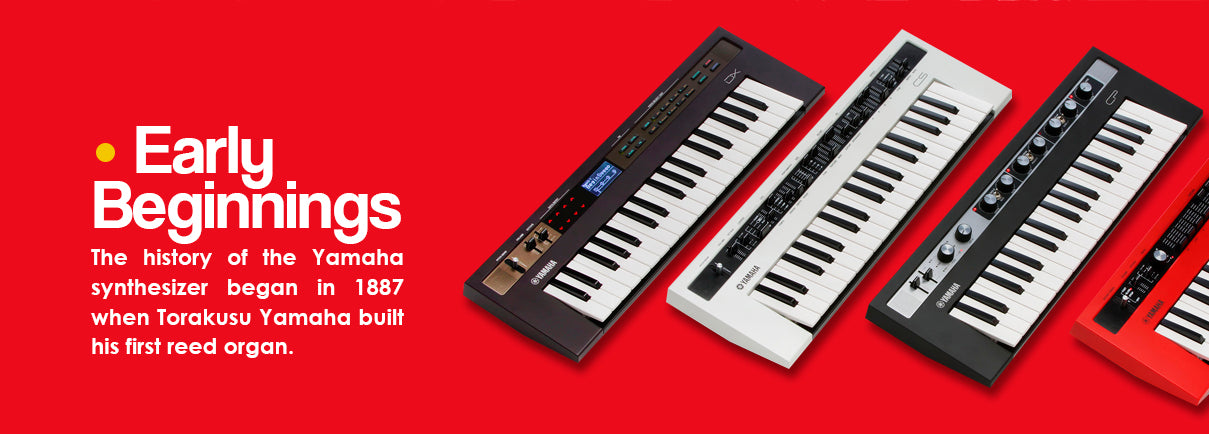
The history of the Yamaha synthesizer began in 1887 when Torakusu Yamaha built his first reed organ. The Yamaha Corporation, initially named Nippon Gakki Co., Ltd. was formed in 1897 and quickly began producing upright acoustic pianos in the 1900s. In 1959, Yamaha created the first electronic keyboard instrument, the D-1 Electone. This revolutionary electronic organ used transistors alone to produce sound, instead of the vacuum-tube technology that was available at the time. The Yamaha Electone would pave the way for later synthesizers — however, it had a long way to go first.
While the D-1 Electone featured unique technology for the time, it still lacked greatly in expressivity and sound quality when compared to other acoustic instruments. The Electone produced notes with an immediate and strong attack that ceased abruptly when the key was released. This mechanic sound did not resemble the way a tone naturally changes over time when produced on instruments like pianos.
Developers at Yamaha knew that it was essential for their electronic keyboards to produce sound variation over time if they were going to be accepted as musical instruments. This motivation to create more interesting and natural sound with their Electone is what led to the development of Yamaha's first synthesizer 15 years later.
Yamaha's First Synthesizer

Before the release of Yamaha's first commercially available synthesizer, the company produced a prototype eight-note polyphonic synthesizer named the GX-707. This model had highly expressive tone generators that showed great advancement toward the natural tone Yamaha was striving for. However, the GX-707 was a massive instrument and weighed over 660 pounds. It also required a separate control board to edit sounds.
For these reasons, the GX-707 was not marketable to the general public and was considered a niche instrument for concert use. The technology used to produce expressive tones in the GX-707 was then used to develop their first synthesizer released on the market, the Yamaha SY-1.
The Yamaha SY-1 was released to the public in 1974 and quickly became an enormous success. This monophonic analog synthesizer used an ADSR envelope generator to produce tones that changed over time by altering the sound in four stages:
- Attack: How quickly a note reaches its peak volume after being struck
- Decay: How fast it drops back to the sustain level
- Sustain: The volume that the note is held at while the key is pressed
- Release: Determines how quickly the sound fades
A pair of sliders on the SY-1, labeledAttack and Sustain, were used to adjust how the tone changed when notes were played. The SY-1 also featured preset envelopes making it even simpler for users to recreate the sounds of a variety of instruments. The musician could activate a preset envelope, such a flute or guitar envelope, by moving a tone lever. While synthesizer presets are common today, this functionality was innovative when the SY-1 was released.
Several other features made the SY-1 a groundbreaking instrument. The SY-1 featured velocity sensitivity and aftertouch, making it extremely expressive to play. Velocity sensitivity allowed the SY-1 synthesizer to respond to the different pressure when a key is struck, just as an acoustic piano would. Aftertouch allows players to apply more pressure to a key after it is held down to create crescendos or vibrato. The user-friendly controls of the SY-1 allowed players to alter sounds directly from the keyboard without using an additional control board.
Due to the popularity of the SY-1, Yamaha also released an organ with a built-in SY-1 synthesizer, called the CSY-1. In 1975, the SY-2 was released with added envelope and filter controls for even more expressiveness. The SY-2 even earned a spot on the silver screen in 1977 when it is used to communicate with aliens in Close Encounters of the Third Kind.
Improved Tone, Memory and Polyphony With the CS Series
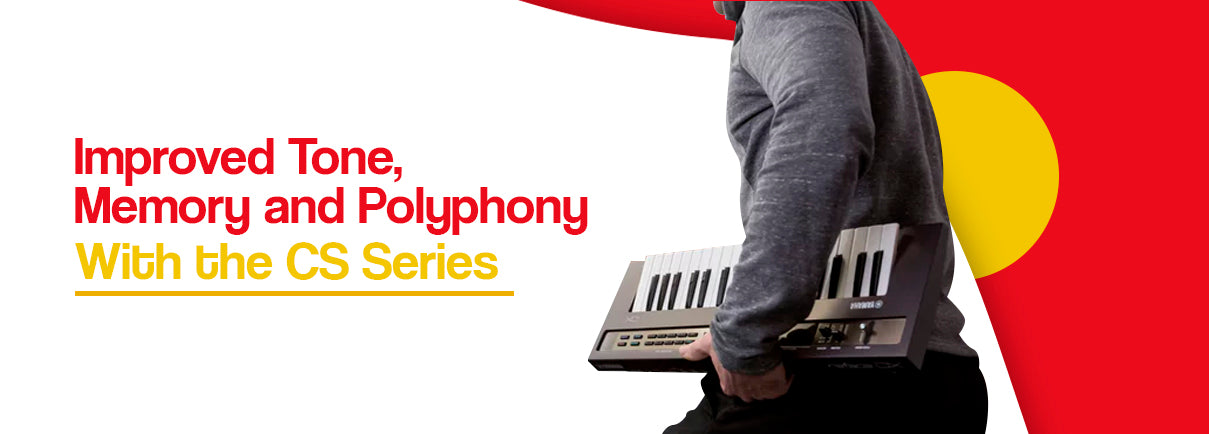
Showing Yamaha's continued focus on high-quality sound, their next series of synthesizers featured a new type of envelope generator for more natural sound variation. Released in 1977, the CS Series synthesizers used an IL-AL envelope generator, which allows players to create Initial Level and Attack Level settings. Users can set the tones at the start and peak of the attack stage, creating greater freedom for altering tones. Compared to the ADSR envelopes, IL-AL envelope generators make it easier to produce a natural sound.
Another significant advancement of the Yamaha CS series synthesizers was their ability to store programmed sounds. Created before the invention of RAM or ROM, these early synthesizers relied on analog technology to save sounds. The CS-80, the flagship model of this series, contained four sets of memory elements that each corresponded to a specific instrument controller, allowing players to switch instantly between four programmed sounds.
Other popular features of the CS-80 were its ability to smoothly bend pitch using a ribbon controller and its aftertouch sensitivity. The aftertouch functionality of the CS series was polyphonic, meaning aftertouch effects could be applied differently to each note depending on the pressure applied to them. Previous synthesizers used channel aftertouch, meaning the pressure applied to one key was channeled across the entire instrument to affect all the keys equally. The CS-80 polyphonic synthesizer also used new integrated circuitry that allowed Yamaha to produce lighter and more portable models.
Throughout the 1970s, three generations of CS Series Yamaha synthesizers were produced, but the flagship CS-80 remained the most popular and is still sought after today. The CS-80 has been featured in famous songs, such as the Blade Runner Theme by Vangelis and Africa by Toto. Other notable artists who used the Yamaha CS-80 include Stevie Wonder, Daft Punk, Giorgio Moroder and ELO.
FM Tone Generators Change the Playing Field
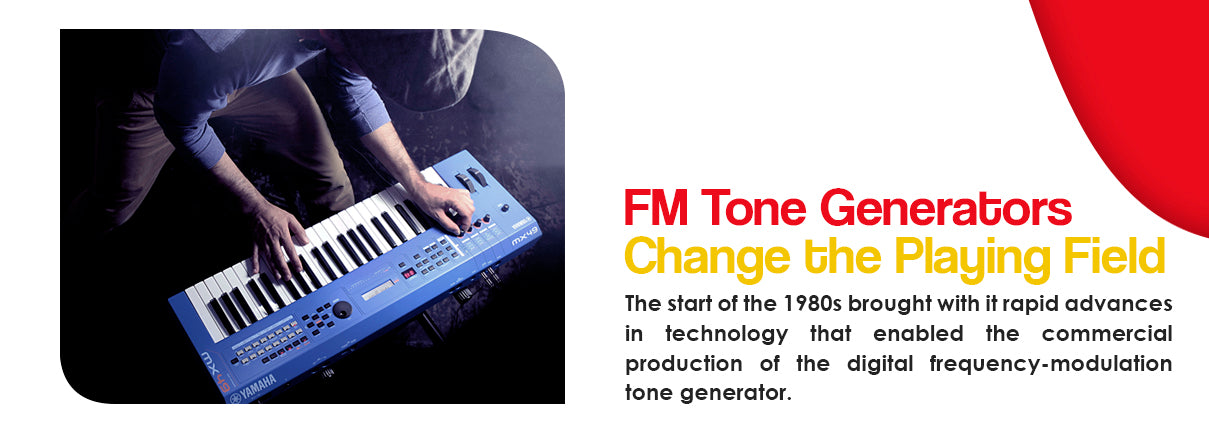
The start of the 1980s brought with it rapid advances in technology that enabled the commercial production of the digital frequency-modulation tone generator. This sound generator, also known as an FM tone generator, would yet again dramatically alter the capabilities of digital sound production.
The FM tone generator was first created by researchers at Stanford University in the 1970s. Recognizing the potential of this new technology, Yamaha quickly signed an exclusive contract with the university in 1973. The Yamaha Corporation began working toward a new digital synthesizer — and at the same time that the SY-1 analog synthesizer was released in 1974, developers had already created a prototype synthesizer with a digital FM tone generator.
However, the prototype instrument involved a large number of integrated circuits that made it impractical for public use. As semiconductor-based technology continued to advance, Yamaha was finally able to release a synthesizer with an FM tone generator in 1981. The F-70 was a classic Electone model with an FM tone generator at its core. Soon after, the company released the GS-1 keyboard with FM technology that was intended for stage use.
The frequency-modulation technology in these synthesizers creates sound using digital oscillators or Operators. These Operators generate audible Carriers and Modulators that change the timbre of the Carrier and modulate the music to create harmonics. Different arrangements of Operators produce different types of sounds. FM synthesizers provided a significant advancement in sound quality and expressiveness. FM tone generators could produce kinds of voice that had not previously been possible, such as metallic and bell-like sounds. They also produced rich harmonies that allowed for intense realism when recreating the sounds of other instruments.
While the GS-1 utilized FM technology, it was not actually marketed as a synthesizer. The GS-1 could produce 16 unique voices that could be changed via voice cards, but the instrument did not allow direct editing of sounds. Instead, a special programming device was used to alter the sounds on the voice cards. To produce a more user-friendly FM synthesizer, Yamaha focused on developing a clear user interface that allowed both editing and programming of sounds to be done directly on the instrument. Their solution was a built-in programmer that used lamps and buttons to confirm the parameter settings when making edits. This simplified user interface paved the way for the creation of the massively popular DX7.
The Revolutionary DX7
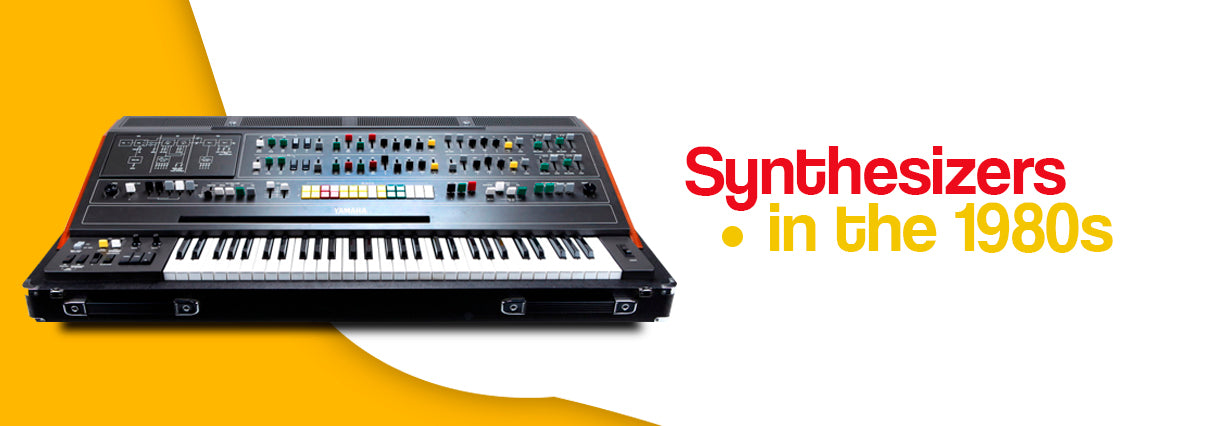
Released in 1983, the DX7 Yamaha Synthesizer took the music world by storm. Featuring a multitude of innovative features, the DX7 quickly became the best-selling synthesizer of its time. Compared to the GS-1, the DX7 featured two additional operators that allowed the production of more elaborate tones. It also provided functionality for creating and editing of sounds directly, as well as storing programmed sounds through memory cartridges.
Below are some of the essential advancements of the DX7 Yamaha synthesizer:
- LCD Screen: The new DX7 featured a small LCD screen that could display parameter settings. This allowed a new level of accuracy that was not possible with previous synthesizers. Older models required programmers to check the positions of knobs and sliders on the control panel, while the new LCD screen clearly confirmed sound programmings. Because the LCD screen reduced the need for dials and controllers, the DX7 also sported a clean and sleek control panel.
- Cartridge-Style Memory: The DX7 was capable of storing 32 voices internally, with the option of accessing an additional 64 voices by inserting a ROM cartridge. Programmers could also use a RAM cartridge to write 32 original voices, significantly expanding the sounds available with the DX7. If players wanted to recreate the sounds of famous musicians, they could now purchase memory cartridges containing the voices of professional synth players. In the past, players of older synthesizer models had to attempt to copy the slider and dial positions of famous players to recreate their sound.
- Expressiveness and Polyphony: The DX7 produced a unique sound and featured dramatic velocity sensitivity. This created a more expressive sound, similar to an acoustic piano. The DX7 also allowed for 16-voice polyphony, which was unprecedented in previous models.
- Affordability: Despite its advanced specifications and features, the DX7 cost about one-tenth of the price of the GS-1, making it shockingly affordable for public use.
However, perhaps the greatest development of the DX7 was its was compatibility with MIDI. In 1982, just one year before the release of the DX7 synthesizer, MIDI was introduced as a new technical standard. MIDI altered the entire music industry by providing a means for the digital exchange of information between musical instruments. Because the DX7 supported MIDI, new technological possibilities became available. Players of the DX7 could use a MIDI sequencer alongside their synthesizer to create high-speed phrases or robotic sounds that would be very difficult to play manually. MIDI sequencers also allowed performances of other musicians to be recreated accurately.
MIDI support also allowed the DX Series synthesizers to play musical parts automatically, which further expanded the instrument's capabilities. Musicians could program two synthesizers to play the same part at slightly different pitches to create a rich sound. Yamaha also developed the TX Series of synthesizers to enable players to perform this function more easily. The TX Series synthesizers did not have a keyboard, and we used them to expand the capabilities of keyboard synths.
Synthesizers in the 1980s
The combination of MIDI performances and the distinctive sound of FM synthesizers produced innovative music that would truly define the 1980s sound. Dance and techno music relied heavily on the robotic and metallic sounds of FM synthesizers, and the DX7 sound became a driving force of pop music of that era. You can hear the Yamaha DX7 Synthesizer in famous songs such as Whitney Houston's "The Greatest Love of All," Berlin's “Take My Breath Away" and Kenny Loggins's "Danger Zone."
Throughout the 1980s, Yamaha would release 55 different models of synthesizers, showing a rapid evolution of synthesizer technology. Home recording was made possible in this era from the development of the multitrack recorder (MTR), which allowed users to record up to four individual tracks on a standard cassette. The original practice was to layer each musical part individually, however, Yamaha created a multi-part tone generator called the TX81Z that could play multiple voices at the same time on different channels. This synthesizer produced a rich, dense sound and streamlined the recording process.
The 1980s also saw a movement toward integrated workstations that allowed producers to create all musical parts with one synthesizer. Yamaha developed the V-50 synthesizer as a powerful model that incorporated a multi-part tone generator, MIDI sequencer, keyboard, rhythm machine and digital effects processors. This multi-faceted Yamaha FM synthesizer was a compelling product that displayed the rapid evolution of the Yamaha synthesizer.
Sampling Arrives in the SY Series
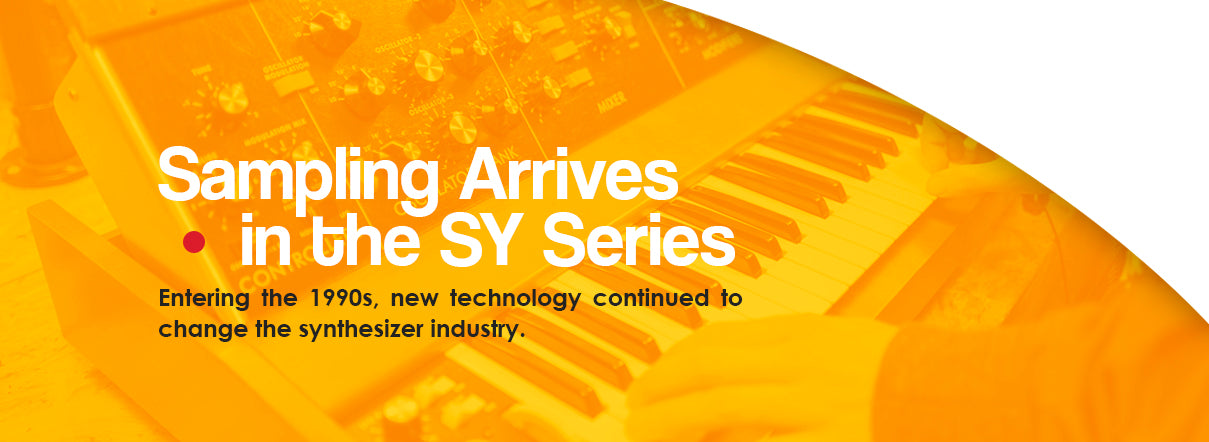
Entering the 1990s, new technology continued to change the synthesizer industry. One of the major advances was PCM sampling, which allowed the sounds of real acoustic instruments to be digitally recorded and used for tone generation. Musicians used short samples of drums, percussion and other effects that could be played back with minimal tone adjustment. Yamaha developed this sampling based on tone generation Advanced Wave Memory (AWM) tone generation. While sampling is now a standard part of music production, it was a huge innovation for its time. The Yamaha SY Series of synthesizers responded to this new technology by incorporating an AWM tone generator with an FM tone generator.
Introduced in 1989, the SY77 was the most successful model of this line and produced unique and expressive sounds by blending FM and sampling. The SY77 could create a wide variety of sounds, including those of a classic FM synthesizer, more realistic acoustic sounds and unique hybrid tones using FM synthesis and AWM tone generation. The SY77 synthesizer also boasted reverb and modulation effects, along with 32-voice polyphony. Complete with an onboard sequencer and floppy disk drive that allowed sounds to be saved and loaded, the SY77 was a powerful workstation for music production.
Enjoy Unique Expression With the VL Series
Released in 1994, the VL Series of synthesizers used a new synthesis technology called Virtual Acoustic developed by Stanford University. This synthesis is based on physical modeling technology, rather than sampling, and the Yamaha VL-1 was one of the first of its kinds to be available on the market. The VL-1 was unique in its ability to recreate the sounds of wind, brass and string instruments with a high level of realism.
The VL-1 allowed musicians to experiment with different ways to play the instrument, including a breath controller. By blowing into the breath controller while playing the keyboard, the MIDI parameters of the notes would change based on the musician's air flow. Skilled players could produce subtle changes in tone and pitch that closely resembled the sounds of real wind instruments, such as saxophones or trumpets. However, the VL-1 was challenging to play, as the user had to manipulate multiple parts and different types of controllers at the same time.
A Modern Workstation Is Created With the MOTIF Line
Released in the early 2000s, the Yamaha MOTIF Series is a powerful workstation for music production. As the popularity and demand for integrated synthesizer workstations grew, Yamaha worked to produce a workstation with better sound quality, ease of use and computer integration. The MOTIF Series is designed to produce a realistic and high-quality sound that mimics acoustic instruments. Its straightforward user interface allows the user to create music easily, and the synthesizer can connect seamlessly with computers and other studio equipment. MOTIF synthesizers allow samples to be imported and exported through a digital output connection.
Another stand-out feature of the MOTIF line is its Integrated Sampling Sequencer (ISS). This functionality allowed audio loops to be created and sliced up with a natural release applied automatically on each slice. With the rise in popularity of audio loops in the early 2000s, ISS made it simple to create high-quality synthesized music.
The MOTIF synthesizers also featured intelligent time stretching, which allowed musicians to play audio loops at different tempos while maintaining a natural sound. The intelligent arpeggiator in the MOTIF synthesizer is another popular feature. Users can program the synthesizer to play constituent notes in sequence up and down when a chord is held. The MOTIF synthesizers can also play trill effects in addition to standard arpeggios, creating an endless potential for expression.
Since the original MOTIF line was released in 2001, Yamaha has produced three more series over the course of 15 years. Each of the four MOTIF Series improves upon the previous model with expanded memory, enhanced aesthetic appeal and greater digital connectivity. MOTIF synthesizers have been used by many famous musicians, including Alicia Keys, Stevie Wonder, Michael MacDonald, Babyface, Chick Corea and David Bryan.
Yamaha's Newest Development — MONTAGE

The newest line of Yamaha synthesizers builds on Yamaha's previous synthesis technology to produce an intuitive, powerful and dynamic workstation. The MONTAGE Line uses a control interface called Motion Control to combine two synthesis engines, the AWM2 and FM-X. The AWM2 features greatly expanded wave ROM from the MOTIF X, and the FM-X features eight Operators and 88 Algorithms for the widest variety of sound production yet.
The united Motion Control interface allows musicians to alter multiple parameters at the same time for new levels of control and creativity. Users can create seamless fading in and out of different sounds and directly control multiple FM-X and effect parameters at the same time. This unprecedented level of real-time control allows up to 128 simultaneous control assignments.
With innovative effects processing, the MONTAGE Music Synthesizer offers delays, vintage effects, HD reverbs and modern effects such as Beat Repeat, Slicer, Spiralizer and more.With a streamlined workflow and dynamic control, the Yamaha MONTAGE Line enters a new era of synthesizers that continue to provide the high-quality sound and reliable performance the Yamaha brand is known for.
Yamaha Synthesizers at Bananas at Large®

As the number one manufacturer of musical instruments in the world, Yamaha offers a variety of high-quality professional synthesizers for anyone from experienced producers to amateur musicians. If you are seeking the latest in synthesizer technology, you can find the newest Yamaha synthesizers at Bananas at Large, including the flagship MONTAGE8 and the 61-key MONTAGE6.
Purchasing your dream synthesizer from Bananas at Large is easy with our simple payment plans and flexible financing options. Explore Yamaha synthesizers today to find the perfect fit for your sound.










